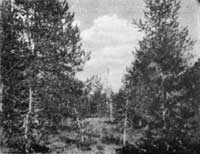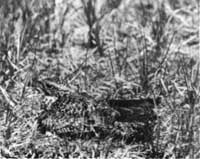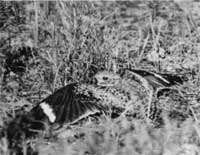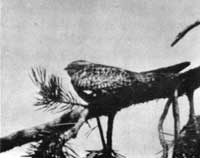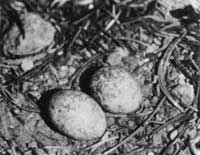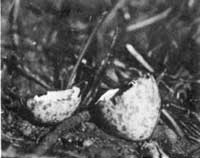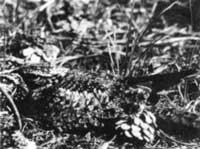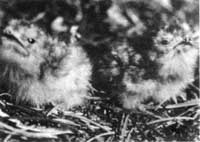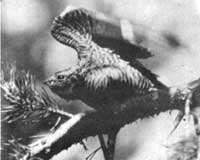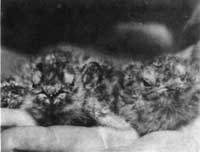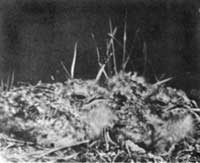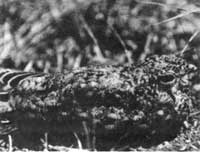Nighthawk Family at Lost Creek
Snakes in Crater Lake National Park
Each summer members of the park staff are asked a few times by cautious visitors, “Are there any snakes here?” or perhaps more frequently, “Are there any poisonoussnakes here?” To the second question we are able to answer promptly and happily, “No.” To the first we could reply that there was only one snake known for the park — until the summer of 1954 at least, but that is another story which I will come to a little farther along.
The only species of snake ever found alive in Crater Lake National Park is Fitch’s Garter snake, Thamnophis sirtalis fitchi Fox. Records for the park through 1951 have been adequately summarized by Farner and Kezer (1953). Since that time, ten specimens have been added to our collections, bringing the total to eighteen. Two new localities are represented among these specimens, Whitehorse Bluff (Crater Lake National Park catalog No. 561) and Quillwort Pond (CLNP 562, 596, 641, 642). Other specimens are from the Crater Spring bogs (CLNP 644) and Wizard Island (CLNP 559, 560, 643, 645).
Two of these snakes (CLNP 643 and 645) are particularly fine melanistic individuals, the latter having been measured at 37-1/4 inches. Both were collected by Ranger-Naturalist John R. Rowley at Fumarole Bay, one on August 22 and the other on August 30, 1954, in almost the identical spot. Apparently both are females. These two snakes are extremely dark — essentially black, in fact. Some parts of the area in which the light color pattern would normally appear are barely discernible as a dark blue-gray.
Together with two earlier collections (CLNP 47, 48), these provide four strongly melanistic specimens from Crater Lake; all were taken on Wizard Island. Two or three other specimens from Crater Lake, while not exhibiting the extreme melanism of the four already referred to, are considerably darker than the typical snake of this subspecies and may represent intermediates between these two conditions. Although snakes with the normal coloration have been found in the lake and on Wizard Island, no specimens exhibiting melanism of this pronounced type have been found within the park except inside the lake basin.
I have been unable to find any reference to such extreme melanism for Thamnophis sirtalis in the literature, other than that of Farner and Kezer (1953). However, varying degrees of melanism among essentially typical specimens are apparently well known (Fitch, 1941; Stebbins, 1954).
Farner and Kezer (1953) suggest that “the conformance of this color with the color of the rocks in the environment may be of selective value.”
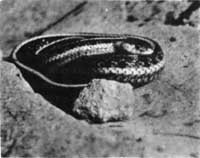 Fitch’s Garter Snake From Kodachrome by Welles & Welles |
Reference is being made to the dark lava rock comprising, particularly, the lower portions of Wizard Island. This possibility would seem to be supported by the studies of Fitch (1941), who found that brightness and distinctness of pattern in Thamnophis ordinoides were influenced more by the nature of the vegetation in the special ecological niches occupied than by climatic and other physical conditions.
On August 24, 1954, a snake was found dead on the Rim Drive, about one to two miles east of the Castle Crest Wild Flower Garden parking area, by Mr. Jack Boykin, a park visitor. Although it was in poor condition and lacked a head entirely, Mr. Boykin brought the specimen to Park Headquarters. It has now been identified fairly certainly as a Pacific rubber boa, Charina bottae bottae Blainville, even without the head characteristics, by reaching a maximum count of forty-five scale rows in several attempts. This specimen has been added to the park collections (CLNP 647).
Fitch (1936) reports only two records for this species in the Rogue River basin, one from Warner Gap and one from ten miles east of Ashland. Klauber (1943) refers to six specimens of the subspecies collected at Prospect, about ten miles south of Union Creek Camp.
The Pacific rubber boa has been observed occasionally in the area of Union Creek Camp, about seven miles west of the western boundary of Crater Lake National Park. Dr. Robert H. McCauley, Jr., captured two specimens at this location only a day or two before he visited Crater Lake National Park on August 12, 1953. He had these snakes with him at the time of his visit in the park. The collection, by a member of the Union Greek Forest Camp staff, of a single specimen in that general area during the summer of 1954 has also come to my attention.
Gordon (1939) and Anderson and Slater (1941) report the rubber boa from both Jackson Co. and Lake Co., immediately adjacent to Klamath Co. on its western and eastern sides, respectively. In spite of the several records mentioned above, all in Jackson Co. and including one locality which approaches Klamath Co. and Crater Lake National Park closer than ten miles, neither Gordon nor Anderson and Slater report the species from Klamath Co. itself. This is the first record, to my knowledge, for the species in Klamath Co.v
It is interesting to note that Charina bottae is not among the species of reptiles listed by Vincent (1947) as unreported but perhaps to be expected within the park. Yet, of the four species of snakes which are listed here by Vincent, none has ever been reported for the park.
Klauber (1943) and Stebbins (1954) both indicate that the range of the rubber boa in Oregon extends across the Cascade Range. The Pacific rubber boa ranges westward from the Cascade Mountains; the Rocky Mountain rubber boa, Charina bottae utahensisVan Denburgh, ranges eastward from these same mountains. Although specific localities for specimens are not cited by either Klauber or Stebbins, it must be assumed that individuals of both subspecies reach the crest of the Cascade Range in some of the same areas since Klauber states that C. bottae utahensis “intergrades with C. bottae bottae along the Cascades from Puget Sound down to Siskiyou County, California,…..”
Thus it seems possible that the finding of a Pacific rubber boa on the Rim Drive may represent the natural distribution of the species. Until more records are available for the park, however, the natural occurrence of this snake within the area must be regarded as a tentative assumption. It is of course possible that this individual was brought into the park by a visitor, as seems most likely in the case of the lizard recently reported new to the park (Brown, 1953).
A visitor to Crater Lake National Park may likely never catch sight of a snake within the area, even if some time should be spent in looking for one. For this reason we are particularly pleased with Mr. Boykin’s discovery of a rubber boa, and we are grateful for the fact that he was sufficiently interested in his find to bring it to our attention. Of course, he had to be observing enough to notice it on the road, the color of which is rather well matched by that of the snake itself. Undoubtedly he had allowed himself enough time to travel the Rim Drive in a leisurely manner and therefore was very much aware of all that might be seen and enjoyed along the way.
So keep your eyes open for these interesting creatures, not so much to avoid stepping on one, but rather to have perhaps the unusual opportunity of watching one of the rarer animals of the park. If you should be fortunate enough to see a snake during your stay here, it may well be a new record. In any event, members of the naturalist staff will be happy to hear about it.
References
Anderson, Oscar I., and James R. Slater. 1941. Life zone distribution of the Oregon reptiles. College of Puget Sound, Dept. Biol. Occ. Pap. 15:109-119
Brown, Richard M. 1953. Lizard adventures on Mt. Mazama. Nature Notes from Crater Lake 19:35-38.
Farner, Donald S., and James Kezer. 1953. Notes on the amphibians and reptiles of Crater Lake National Park. Amer. Midl. Nat. 50(2):448-462.
Fitch, Henry S. 1936. Amphibians and reptiles of the Rogue River basin, Oregon. Amer. Midl. Nat. 17(3):634-652.
—– 1941. Geographic variation in garter snakes of the species Thamnophis sirtalis in the Pacific Coast region of North America. Amer. Midl. Nat. 26(3):570-592.
Gordon, Kenneth. 1939. The amphibia and reptilia of Oregon. Oregon State Monographs, Studies in Zoology 1:1-82.
Klauber, Laurence M. 1943. The subspecies of the rubber snake, Charina. Trans. San Diego Soc. Nat. Hist. 10(7):83-90.
Schmidt, Karl P. 1953. A Check List of North American Amphibians and Reptiles (6th ed.). Chicago, University of Chicago Press. viii, 280 pp.
Stebbins, Robert C. 1954. Amphibians and Reptiles of Western North America. New York, McGraw-Hill Book Co., Inc. xxii, 528 pp.
Vincent, W. S. 1947. A check list of amphibians and reptiles of Crater Lake National Park. Crater Lake National Park Nature Notes 13:19-22.

